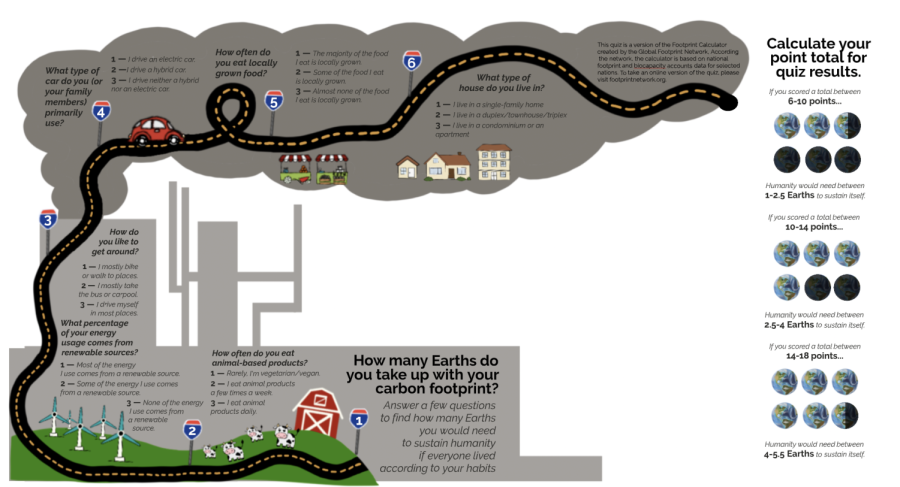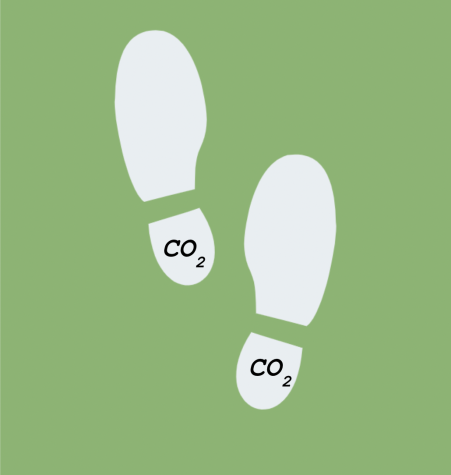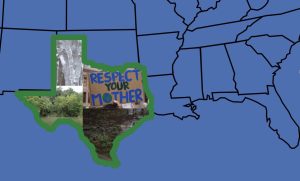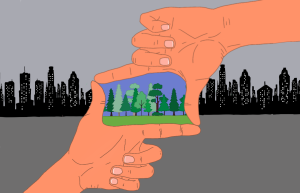What’s driving your CO2 emissions?
Students make conscious efforts to reduce carbon footprints through everyday actions, habits
CO2 use can be measured by what’s known as a “carbon footprint” which analyzes lifestyle choices to calculate average emissions. Carbon footprint factors in many areas, from the car you drive to the food you eat.
March 3, 2023
World geography is the required social studies class for all freshmen. It’s a class that sets the pace for what students will learn about in history for the rest of their time in high school.
But for junior Ellie Loudermilk, that world geography class changed the course of her life.
It started with a carbon footprint quiz. Loudermilk’s results: It would take four Earths to sustain humanity if everyone lived like her. So, she decided to make a change.
“I became a vegetarian after that quiz,” Loudermilk said “I saw that I used three too many worlds and I thought ‘This is horrible.’ I wondered, ‘What can what really can one person do about it?’ But I feel like I have to do what I can.”
A carbon footprint quiz analyzes the lifestyle of an individual to calculate their carbon emissions. This type of analysis also allows one to determine which areas of their life release the most CO2.
“Carbon footprint is how much greenhouse gases an individual emits into the atmosphere,” senior and Austin Climate Coalition member Malia Walewski said. “Currently humans are putting way too much carbon dioxide into the Earth and it’s a major cause of the climate crisis.”
Austin Climate Coalition is a student-run group that extends across multiple different Austin schools that works to fight climate change.
“It’s an organization that was founded at a climate march in 2018 by high schoolers from across central Texas,” Walewski said. “We focus on promoting local sustainability and lobbying local/state government members to advocate and approve climate friendly legislation. We seek to influence those in power by using our voices as young people because, after all, our votes are the future.”
Loudermilk, however, wasn’t aware of this organization at the time. She just knew she wanted to make change. As the meat industry is a huge contributor to global carbon emissions, going vegetarian was a way for Loudermilk to make a realistic change to her own lifestyle.
“A lot of my carbon footprint was based off of the meat that I ate every day,” Loudermilk said. “My mom grew up eating like this at the her childhood restaurant. My grandma has diabetes because she ate like the most rich beef for dinner every night. Eating meat was so ingrained in our lifestyle, that it was kind of hard to change.”
Despite the difficulty, Loudermilk put in the work. Now, being a vegetarian feels almost like second nature.
“I feel like I don’t really have to think about it that much,” Loudermilk said. “Even though climate change is like always there and if you’re doing something that you don’t really even have to think about, like being a vegetarian, you’re making change without working for it.”
Other ways to lower your carbon emissions include carpooling or biking for transportation, eating locally grown food, utilizing forms of renewable energy, turning of light switches and unplugging devices when they are not in use, and looking at your own personal carbon footprint.
“It’s a helpful unit of measurement for someone’s greenhouse gas output,” Walewski said.
For Loudermilk, the initial hurdle of going vegetarian was finding ways to eat around a family of meat eaters.
“The hardest part about being a vegetarian is how you are with other people because everybody else around me eats meat, especially my family,” Loudermilk said. “Luckily my mother was very nice about it, so she would like make vegetarian options for me right at dinner, but I feel like a lot of families don’t have a chef in the house that will change meals.”
But by making conscious choices when preparing meals, the initial challenges of this lifestyle payed off for Loudermilk.
“It’s actually it’s very easy,” Loudermilk said. “My mom will make a dinner like a stir fry, and she’ll make my dinner first, which is just a normal stir fry. Then after she makes mine, she’ll add meat in for the rest of the family, which is really easy.”
Even for those who don’t want to shift their diet completely, Loudermilk believes there are other ways to help.
“You don’t have to go full vegetarian to lower your carbon footprint,” Loudermilk said. “You could just like I don’t know, not eat meat every for every meal and have meat every few days of the week instead of every day, which I think is attainable.”
Loudermilk herself even “cheats” on her vegetarianism on special occasions. In her mind, it’s more about the big picture — everybody pitching in and doing what they can, no matter how much that may be.
“Even the little things are so important,” Loudermilk said. “Because even if I’m not making the biggest carbon footprint change, I’m making my own change, and I know that I’m doing the most I can. I’m not forcing it onto anyone, but I am doing what I can do to save.”








